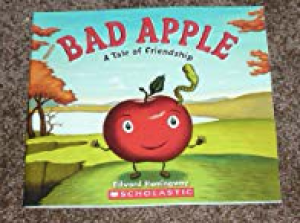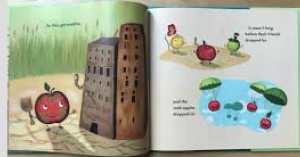

Title – Bad Apple: A Tale of Friendship
Author(s) – Edward Hemmingway
Illustrator/Photographer – Edward Hemmingway
Publisher and Year – Scholastic, 2012
Number of pages – 32 pages
Tags/Themes – Rylie Loux, Friendship, Emotion, K-5
Genre – Fiction
Descriptive Annotation: This story is about an apple named Mac and his unlikely friendship with a worm named Will. At the start of the book, the duo is inseparable, finishing each other’s sentences and playing games. But apples aren’t supposed to be friends with worms, so other apples in the orchard start bullying Mac calling him “rotten” and “bad apple.” In the end, Mac is a “good apple” who gains the courage to stand up to the bullies and learns the importance of being a loyal friend.
Classroom Application: This is a perfect resource for engaging students in an anti-bullying lesson. By bringing this book to the classroom, it can help express the issue of bullying to the class and how to prevent it and help kids who are experiencing it. The ideology that is presented in this story is the importance of kindness and acceptance of others, helping students understand that each and everything they do makes a difference on someone else. To incorporate this into the classroom, I would present it at the beginning of the school year to set the standards of bullying in the classroom. Also the students could create a venn diagram to compare and contrast Mac (the good apples) with the bullies in the story (bad apples). Also the students could also make a list of qualities of a good friend.
Linguistic and Cultural Diversity Analysis: The main ideology that is presented is bullying. A quote from the story is “But no one in the orchard would play with them.” This gives the students the ability to see themselves in this situation because each day they talk and play with other students in their class. “Luckily Mac knew he’d rather be a bad apple with Will than a sad apple without him.” This expresses that Mac would rather be stand out and be friends with Will rather than fit in with everyone else. This teaches children to stand up for what they want rather than what it “cool” or popular. This story gives students a way to learn the importance of accepting one another and to not bully their classmates.
